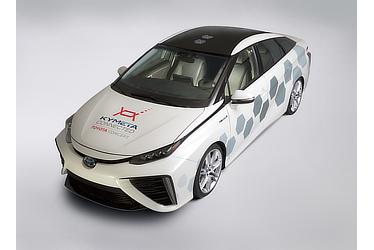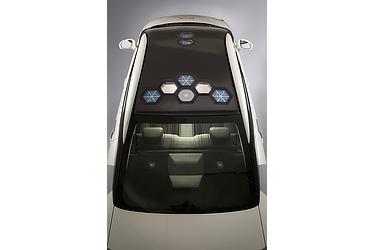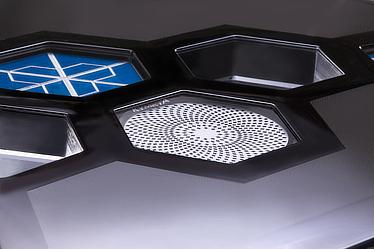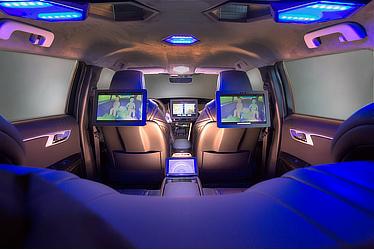Jan. 12, 2016
Toyota Displays a Mirai-Based Research Vehicle
with Satellite Communications Function
Accelerates Connected Technology Development through Collaboration with Kymeta
Detroit, MI, January 12, 2016―At the 2016 North American International Auto Show (NAIAS), Toyota is displaying a research vehicle based on the Mirai fuel cell vehicle which is equipped with satellite communications technology from Kymeta, a U.S.-based company that is the world's leader in flat-panel antenna technology.
Toyota is working to enhance its connected technologies, including a plan to install a Data Communication Module into a broader range of its vehicles. The company is also considering using satellite communications in the future, including high capacity satellites that offer much higher data transfer rates than conventional satellite technologies.
While these satellites have historically required the use of a "dish" antenna on the ground, Kymeta's satellite antennas remove the need for mechanical components by using software and liquid crystal technologies to electronically track and steer towards satellites. The lightweight, flat profile of the antenna also allows for seamless integration during vehicle assembly or easy aftermarket installation.
"For several years, Toyota met with emerging companies around the world to investigate new technologies," said Shigeki Tomoyama, Senior Managing Officer of Toyota Motor Corporation. "We were very excited to learn about Kymeta, because their flat antennae technology could solve the challenge of vehicle-based satellite communications."
Satellite communications offer several key benefits to meet automotive needs, including 1) the distribution of huge amounts of data to a vehicle, 2) broad coverage areas and the global deployment of connected vehicles that share common standards across national borders, and 3) more stable and secure communications, particularly in emergencies such as natural disasters.
"We're excited to be working with Toyota on this next generation of vehicle connectivity," said Dr. Nathan Kundtz, CEO of Kymeta. "Kymeta is the first company to successfully demonstrate this type of technology, and we have over 8,000 miles of road testing with cars connected to satellites."
Since September 2013, Toyota and Kymeta have been jointly researching on-car flat antennae to support satellite distribution of huge amounts of data to a vehicle. With an exclusive right for development and testing of the on-car antenna, Toyota lent the company research vehicles for test driving. The Mirai displayed at NAIAS represents the progress of these efforts.
Mirai Creation Investment Limited Partnership, a fund where Toyota participates as an investor, provided an investment of 5 million dollars to Kymeta this month to enhance future technology research and development. Toyota expects acceleration of the joint research with Kymeta through the investment.
Toyota continues to work to accelerate connected car development and introduction including use of satellite communications, to offer customers ever-better car experience.
Remarks by Senior Managing Officer Shigeki Tomoyama
at 2016 North American International Auto Show
Thank you for coming.
I am very happy to be here today to announce Toyota's partnership with Kymeta, and to share the potential for vehicle satellite communications.
As many of you know, last week Toyota announced the framework for our next generation connected vehicles at the 2016 Consumer Electronics Show.
This framework uses vehicle data management to help make ever better cars.
In the coming years, we plan to increase vehicle connectivity in order to provide our customers with better services, such as updating 3D map data and software and various infotainment options.
Obviously, this framework would work very well with a secure, high bandwidth communications system with a global coverage area.
Toyota has investigated satellite technology for many years. It offers several important benefits for vehicle communications.
First, satellite has a global and stable coverage area.
Second, it can transmit huge amounts of data.
Third, it can provide stable communications in case of an emergency or natural disaster.
Of course, for automotive use, satellite has challenges as well. Most important, it is very difficult to fit a large bowl-shaped antenna onto the car.
That is why Toyota is so excited about Kymeta.
For several years, Toyota met with emerging companies around the world to investigate new technologies.
We were very excited to learn about Kymeta, because their flat antenna technology could solve the challenge of vehicle-based satellite communications.
Since September 2013, Toyota and Kymeta have conducted joint research on flat antennas for use in cars.
Today, I am happy to announce that we have entered into an agreement giving Toyota exclusive right to the development and testing of the on-car antenna.
In addition, Mirai Creation Investment Limited Partnership, a fund where Toyota participates as an investor, has invested $5 million in Kymeta to enhance future technology research and development.
There is still much work to be done, and our project is still in the research stage.
However, I hope you can see how exciting this new technology is, and what it could mean for the future of connected vehicles.
Thank you.









